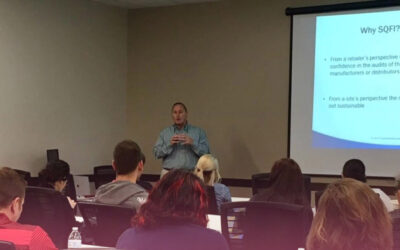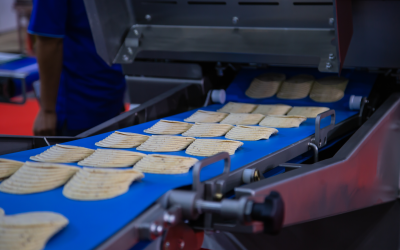FSNS Certification & Audit performs hundreds of food safety certification audits each year, including for SQF certification. We compiled a list of the top 10 reasons for an SQF audit non-conformity that our auditors see to help you prepare for your next audit.
We found that many non-conformities overlap. For example, a non-conformity for improper storage of chemicals is often associated with a non-conformity for improper cleaning or sanitation. This information can help you identify areas that tend to be overlooked so you can ensure your processes are ready to pass your next audit.
Below, we provide the SQF code (edition 9) clause and item for each of the top 10 non-conformities. Here’s the full list:
10) Verification, Training, Validation, and Recordkeeping
Several non-conformities occur with the same frequency in a number of important areas that deserve mention at #10 on the list:
2.5.2.2 – Verification Activities
A verification schedule outlining the verification activities, their frequency of completion, and the person responsible for each activity shall be prepared and implemented. Records of verification of activities shall be maintained.
Common Problems:
- Lack of schedule altogether.
- Failure to follow defined schedule.
2.9.2.2 – Training Materials
Training materials, the delivery of training, and procedures on all tasks critical to meeting regulatory compliance and the maintenance of food safety shall be provided in language(s) understood by staff.
Common Problems:
- Not training employees on Critical Quality Points (CQPs).
2.4.4.6 – Inspection Records
Records of all inspections and analyses shall be maintained.
Common Problems:
- Not recording the inspections defined within the quality programs.
- Evidence of statistical analyses not being maintained.

9) Cleaning and Sanitation – 9.2.5.1/11.2.5.1
The ninth item on our list of top 10 reasons for an SQF audit non-conformity involves cleaning and sanitation practices.
The methods and responsibility for the effective cleaning of the food handling and processing equipment and environment and storage areas shall be documented and implemented. Consideration shall be given to:
i. What is to be cleaned;
ii. How it is to be cleaned;
iii. When it is to be cleaned;
iv. Who is responsible for the cleaning;
v. Validation of the cleaning procedures for food contact surfaces (including CIP);
vi. Methods used to confirm the correct concentrations of detergents and sanitizers; and
vii. The responsibility and methods used to verify the effectiveness of the cleaning and sanitation program.
Common Problems:
- Daily tasks on the Master Sanitation Schedule (MSS) not being documented.
- Cleaning procedures not specific to the piece of equipment.
- Product residue remaining on food contact and adjacent equipment following pre-operational inspection.
- Not rinsing equipment after cleaning with detergents.
8) Storage of Hazardous Chemicals and Toxic Substances – 9.6.5.1/11.6.4.1
Hazardous chemicals and toxic substances with the potential for food contamination shall be:
i. Clearly labeled, identifying and matching the contents of their containers;
ii. Included in a current register of all hazardous chemicals and toxic substances that are stored on-site; and
iii. Supplemented with current Safety Data Sheets (SDS) made available to all staff.
Common Problems:
- Containers of chemicals without labels.
- Unrestricted access.
7) Internal Audits and Inspections (Mandatory) – 2.5.4.1
The methods and responsibility for scheduling and conducting internal audits to verify the effectiveness of the SQF System shall be documented and implemented. Internal audits shall be conducted in full and at least annually. The methods applied shall ensure:
i. All applicable requirements of the SQF Food Safety Code: Food Manufacturing are audited per the SQF audit checklist or a similar tool;
ii. Objective evidence is recorded to verify compliance and/or non-compliance;
iii. Corrective and preventative actions of deficiencies identified during the internal audits are undertaken; and
iv. Audit results are communicated to relevant management personnel and staff responsible for implementing and verifying corrective and preventative actions.
Common Problems:
- Not including each applicable element of the SQF code (i.e. lack of review for food safety culture, management commitment, internal auditing, customer complaints).
- Not including objective evidence in the internal audit reports.
- Failure to document corrective actions for deviations identified during an internal audit.
- Failure to include the root cause and preventive measures; root cause not sufficiently exhaustive.
Download our SQF Audit Checklists to help prepare for your audit. We have two checklists available, depending on your Food Sector Category:
SQF Audit Checklist for Food Sector Categories 10-22, 25, & 33

SQF Audit Checklist for Food Sector Categories 7-9

6) Calibration – 9.2.3.4
Procedures shall be documented and implemented to address the resolution of potentially affected products, when measuring, test, or inspection equipment is found to be out of calibration.
Common Problems:
- Not documenting actions taken when measuring devices are found out of calibration (i.e. scales, thermometers, etc.).

5) Staff Engaged in Food Handling and Processing Operations – 11.4.1.1/9.4.1.1
The fifth item on our list of top 10 reasons for an SQF audit non-conformity encompasses personnel who handle and process food.
All personnel engaged in any food handling, preparation, or processing operations shall ensure that products and materials are handled and stored in such a way as to prevent damage or product contamination. They shall comply with the following processing practices:
i. Personnel entry to processing areas shall be through the personnel access doors only;
ii. All doors are to be kept closed. Doors shall not be open for extended periods when access is required for waste removal or receiving of product/ingredient/packaging;
iii. Packaging material, product, and ingredients shall be kept in appropriate containers as required and off the floor;
iv. Waste shall be contained in the bins identified for this purpose and removed from the processing area on a regular basis and not left to accumulate; and
v. All wash down and compressed air hoses shall be stored on hose racks after use and not left on the floor.
Common Problems:
- Door seals.
- Hose nozzles on the floor.
- Personnel flow and handling posing a risk to product contamination (i.e. personnel handling an insanitary item then handling product).
- Packaging material storage areas not being maintained with packaging material stored against the wall.
The auditor will observe packaging and processing lines in action to ensure personnel are following food safety standards. They will also observe the production environment for non-conformities, so make sure to pay close attention to anything that might catch their eye, like a hose nozzle lying on the floor or a damaged door seal.
4) Cleaning and Sanitation – 9.2.5.3/11.2.5.3
Detergents and sanitizers that have been mixed for use shall be correctly mixed according to the manufacturers’ instructions, stored in containers that are suitable for use, and clearly identified. Mix concentrations shall be verified and records maintained.
Common Problems:
- Improper titration – manufacturer procedures not being followed.
- Chemical titration errors without follow-up corrections.
- Poor titration recordkeeping.
- Titration chemicals expired.
The auditor will often ask to see a titration, so be prepared. Improper titration is one of the most frequent non-conformities found during an audit.
3) Validation and Effectiveness (Mandatory) – 2.5.1.1
The methods, responsibility, and criteria for ensuring the effectiveness of all applicable elements of the SQF Program shall be documented and implemented. The methods applied shall validate that:
i. Good Manufacturing Practices are confirmed to ensure they achieve the required results;
ii. Critical food safety limits are reviewed annually and re-validated or justified by regulatory standards when changes occur; and
iii. Changes to the processes or procedures are assessed to ensure the controls are still effective. Records of all validation activities shall be maintained.
Common Problems:
- Validation activities not summarized to demonstrate what was reviewed to reach a conclusion for the program being validated.
- Not validating for each element defined in the Good Manufacturing Practices (module 9/11) (i.e. waste management, maintenance, etc.).
- Not validating that your policies are achieving the desired results.
It’s important to conduct thorough validations for each program element, and to document that work in your records. We often see non-conformities when people say they’re going to validate their program by, for example, reviewing test results or customer complaints, but then they fail to review those elements. Make sure you follow up on what you say you’re going to do.
2) Corrective and Preventative Actions – 2.5.3.2
Number 2 on our list of top 10 reasons for an SQF audit non-conformity involves root cause analysis, a major component of any food safety certification.
Records of all investigation, root cause analysis, and resolution of non-conformities, their corrections, and the implementation of preventative actions shall be maintained.
Common Problems:
- Failure to identify and document a true root cause.
- Preventive actions that do not address the root cause identified in the documented corrective actions.
Auditors frequently uncover the failure to identify and document a true root cause in the event of a deviation from a food safety requirement, be it a customer complaint, non-conformity during an internal audit, non-conformity with respect to equipment, or another issue.
Spend extra time addressing root cause analysis and documentation to help avoid the second most common non-conformity we see during an audit.
1) Management Review (Mandatory) – 2.1.2.1
That brings us to #1 on our list of top 10 reasons for an SQF audit non-conformity – Management Review. The SQF code (edition 9) states:
The SQF System shall be reviewed by senior site management at least annually and include:
i. Changes to food safety management system documentation (policies, procedures, specifications, food safety plan);
ii. Food safety culture performance;
iii. Food safety objectives and performance measures;
iv. Corrective and preventative actions and trends in findings from internal and external audits, customer complaints, and verification and validation activities;
v. Hazard and risk management system; and
vi. Follow-up action items from previous management reviews.
Common Problems:
- Failure to review culture plan for effectiveness.
- Failure to implement the culture plan (i.e. plan mentions conducting annual surveys, but surveys were not performed).
- Performance measures not defined or evidence of review not provided.
To avoid the most common SQF audit non-conformity, review each of the 6 items in this clause carefully. The top problem our auditors see is a failure to review the plan’s effectiveness. It’s a vital component to your food safety plan and must be done at least annually.
Unraveling the Top 10 Reasons for an SQF Audit Non-Conformity: Recap
Our exploration of the top 10 reasons for SQF audit non-conformity revealed significant overlaps, emphasizing the importance of systematic preparation and thorough documentation.
Persistent themes include the importance of proper validation and recordkeeping, proactive management review, and the rigorous implementation of corrective and preventative actions. To navigate your next audit with confidence, heed these lessons, and continually invest in strengthening your food safety management system.
Reach out to our certification and audit experts with questions or to schedule your next SQF audit




